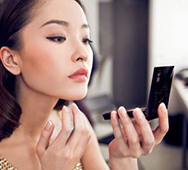Significant societal changes and quality-of-life augmentation in China are compelling Chinese consumers to put on a better face. China is seeing a crucial and auspicious shift in women’s life styles as they become more inspired by emerging career opportunities, access more disposable income, and generally seek greater life expectations. Their notable and increasing independence is being combined with a professional impetus to focus on their appearance – the latter often inspired by celebrity-led trends.
However, with the Chinese economic growth tapering from a GDP of 9.2% in 2011 to 7.8% in 2012, consumers have become more price-sensitive and have reduced their salon and spa visits. That said, Chinese consumers determined to tackle their beauty concerns and desires are still willing to spend. Offering worthy challenges, despite lessened traffic, the professional market in China is seeing a steady increase.
Posting a solid 5% growth, the professional skin care market is seeing foreign brands experiencing faster growth than local ones with the exception of local Chlitina, which posts above-average market growth due to its mature sales network, strong brand reputation, and strong senior management.
In general, the Chinese are inclined to perceive foreign products as more desirable, associating them with higher quality and the cachet of a premium purchase. Foreign products are particularly popular within the younger, trend-setting, demographic and foreign brands are expected to continue to outpace domestic brands through 2017 according to Kline’s recent Professional Skin Care: Global Series report.
The top skin care concerns in China include dehydration, skin whitening, and anti-aging. Anti-dehydration products are popular typically during the fall and winter, and the demand is larger in the northern China region, where the climate is more arid than the southern area.
Seeking lighter colored skin remains an ongoing trend persisting across most demographics, but youth in particular. Lighter colored skin is traditionally perceived as a sign of an elevated social status and appears firmly established within the Chinese market’s concept of beauty, this being borne out by a CNY 940.9 million (USD 149.6 million) spend on skin whitening products in 2012 alone.
With a CAGR exceeding 6% between 2007 and 2012, the salon hair care market is largely being driven by increasing salon doors and rising incomes. Hair coloring is the most dynamic category, thanks to educative marketing, celebrity-driven fashion trends, and consumers being more image conscious, reveals Kline’s latest Salon Hair Care report. Increasing consumer concerns with hair and scalp health, including issues such as hair loss, are boosting the growth of shampoos and conditioners. Of particular note is that consumer written salon reviews are growing in importance as savvy consumers are increasingly using review sites, such as Dazhong Dianping (similar to Yelp), to read about and comment upon salons.
To polish things off, Kline’s Professional Nail Care report reveals that China is the second largest market for professional nail care products, accounting for over 20% share of the Asia-Pacific regional market according Kline’s Professional Nail Care report. Again, the price-conscious consumers hold away with low-cost brands widely available in salons, including premium nail salons, to successfully attract a greater clientele.
China’s changing skin, hair, nail care needs, and consumer behavior patterns are comprehensively assessed in Kline’s Professional Segment.

